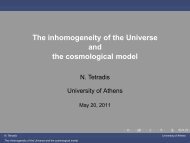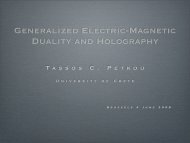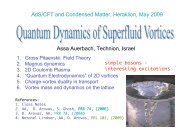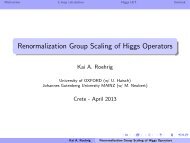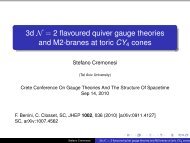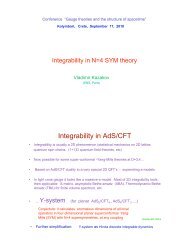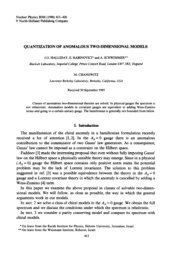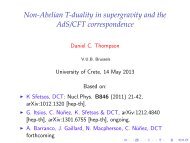Non-equilibrium phase transition from AdS/CFT
Non-equilibrium phase transition from AdS/CFT
Non-equilibrium phase transition from AdS/CFT
You also want an ePaper? Increase the reach of your titles
YUMPU automatically turns print PDFs into web optimized ePapers that Google loves.
<strong>Non</strong>-<strong>equilibrium</strong> <strong>phase</strong><br />
<strong>transition</strong> <strong>from</strong> <strong>AdS</strong>/<strong>CFT</strong><br />
Mohammad Ali-Akbari<br />
School of particles and accelerators, IPM, Iran<br />
Seventh Crete regional meeting on string theory<br />
Kolymbari 2013
Outline<br />
1. <strong>Non</strong>-<strong>equilibrium</strong> system: non-<strong>equilibrium</strong> steady sates.<br />
2. <strong>Non</strong>-<strong>equilibrium</strong> <strong>phase</strong> <strong>transition</strong> of differential conductivity.<br />
3. <strong>AdS</strong>/<strong>CFT</strong> correspondence + matter fields<br />
4. <strong>Non</strong>-linear conductivity in the presence of magnetic field:<br />
3.1: D3-D7 system.<br />
3.2: D3-D5(supersymmetric and non-supersymmetrc) systems.
<strong>Non</strong>-<strong>equilibrium</strong> system<br />
Challenging problem: Physical system at non-<strong>equilibrium</strong> <strong>phase</strong>.<br />
1. Local <strong>equilibrium</strong> Hydrodynamics<br />
2. <strong>Non</strong>-<strong>equilibrium</strong> steady states:<br />
They have no macroscopically observable time dependence.<br />
Y. Oono, and M. Paniconi, “Steady state thermodynamics,” Prog. Theor. Phys. Suppl. 130, 29--44 (1998<br />
S. Sasa and H. Tasaki, ``Steady state thermodynamics,'' [cond-mat/0411052].<br />
Z. Racz, ``<strong>Non</strong><strong>equilibrium</strong> <strong>phase</strong> <strong>transition</strong>,'' [cond-mat/0210435].<br />
B. Derrida, ``<strong>Non</strong> <strong>equilibrium</strong> steady states: fluctuations and large deviations of the density and of the
Conductivity:<br />
<strong>Non</strong>-linear conductivity:<br />
Duo to the non-linearity of conductivity, differential conductivity may be<br />
either positive or negative.<br />
Positive differential conductivity(PDC)<br />
Phase <strong>transition</strong><br />
Negative differential conductivity(NDC)<br />
Strong interaction<br />
<strong>AdS</strong>/<strong>CFT</strong> correspondence as a theoretical<br />
framework<br />
Y. Taguchi, T. Matsumoto, Y. Tokura, “Dielectric breakdown of one-dimensional Mott<br />
insulators<br />
Sr 2 CuO 3 and SrCuO 2 ,” Phys. Rev. B 62, 7015–7018 (2000)<br />
Takashi Oka, Hideo Aoki, ” <strong>Non</strong><strong>equilibrium</strong> Quantum Breakdown in a Strongly
<strong>AdS</strong>/<strong>CFT</strong> correspondence<br />
IIB string theory on<br />
<strong>AdS</strong>(5)xS(5)<br />
N=4 D=4 superconformal<br />
Su(N) gauge theory<br />
D3-D7:<br />
D3<br />
D7<br />
Probe limit<br />
<strong>AdS</strong> background + D7-brane<br />
A. Karch and E. Katz, JHEP 0206, 043 (2002) [hep-th/<br />
0205236].<br />
Strongly coupled Su(N) gauge theory<br />
+ fundametal matters
<strong>AdS</strong> background + D7-brane<br />
(A reminder)<br />
D7-brane is extended along .
Gauge theory side<br />
Gravity side<br />
1. Strongly coupled thermal field<br />
theory.<br />
2. Explicit charge carriers.<br />
3. Electric and magnetic fileds.<br />
1. BH -<strong>AdS</strong> Sch.<br />
2. Time component of the gauge field<br />
on the D7-branes ( ).<br />
3. The spatial components of the<br />
gauge field.<br />
4. (non-linear)<br />
Conductivity .<br />
4.<br />
Mass of the fundamental<br />
matter<br />
A. Karch and A. O'Bannon, ``Metallic <strong>AdS</strong>/<strong>CFT</strong>,‘’ JHEP 0709, 024 (2007), [arXiv:0705.3870 [hepth]].<br />
A. O'Bannon, ``Hall Conductivity of Flavor Fields <strong>from</strong> <strong>AdS</strong>/<strong>CFT</strong>,‘’ Phys. Rev. D 76, 086007 (2007),
A. Karch and A. O'Bannon, ``Metallic <strong>AdS</strong>/<strong>CFT</strong>,‘’ JHEP 0709, 024 (2007), [arXiv:0705.3870 [hepth]].<br />
A. O'Bannon, ``Hall Conductivity of Flavor Fields <strong>from</strong> <strong>AdS</strong>/<strong>CFT</strong>,‘’ Phys. Rev. D 76, 086007 (2007),<br />
D7-branes action<br />
Conductivity equations<br />
Current<br />
Asymptotic behaviour<br />
Mass
Current<br />
We need to solve the equation of motion for<br />
its asymptotic value<br />
for given E, B and temperature.<br />
to find<br />
S. Nakamura, ``<strong>Non</strong><strong>equilibrium</strong> Phase Transitions and <strong>Non</strong><strong>equilibrium</strong> Critical Point <strong>from</strong><br />
<strong>AdS</strong>/<strong>CFT</strong>,‘’<br />
Phys. Rev. Lett. 109, 120602 (2012) [arXiv:1204.1971 [hep-th]].<br />
S. Nakamura, ``Negative Differential Resistivity <strong>from</strong> Holography,‘’ Prog. Theor.<br />
Phys. 124, 1105 (2010) [arXiv:1006.4105 [hep-th]].<br />
M. Ali-Akbari and A. Vahedi, ``<strong>Non</strong>-<strong>equilibrium</strong> Phase Transition <strong>from</strong> <strong>AdS</strong>/<strong>CFT</strong>,‘’ arXiv<br />
1305.3713 [hep-th].
: Insulator <strong>phase</strong> : Conductor <strong>phase</strong>
Small-J region: NDC<br />
Large-J region: PDC<br />
Blue curve : First order <strong>phase</strong> <strong>transition</strong><br />
Red curve: Second order <strong>phase</strong> <strong>transition</strong><br />
Green curve: Crossover
Hamiltonian<br />
Energy<br />
It numerically turns out that the solutions with the<br />
largest value of the electric field have the lowest<br />
energy.<br />
A. Karch and A. O'Bannon, ``Metallic <strong>AdS</strong>/<strong>CFT</strong>,‘’ JHEP 0709, 024 (2007), [arXiv:0705.3870 [hepth]].<br />
A. O'Bannon, ``Hall Conductivity of Flavor Fields <strong>from</strong> <strong>AdS</strong>/<strong>CFT</strong>,‘’ Phys. Rev. D 76, 086007 (2007),
D3-D5 systems<br />
Supersymmetric<br />
D3-D5<br />
Current<br />
2+1 dimensional subspace on which the matter fields live.
<strong>Non</strong>-supersymmetric<br />
D3-D5<br />
1+1 dimensional subspace on which the matter fields live.<br />
Current
Results






